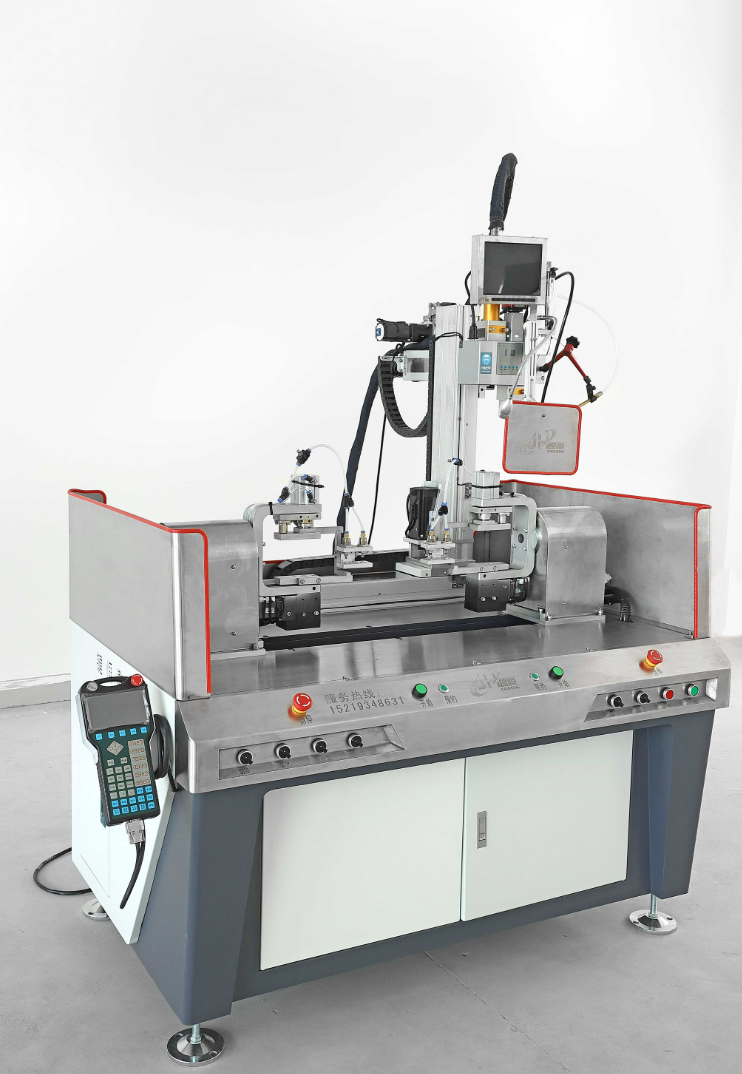How Automatic Laser Welders Work: Core Components and Technological Foundations
Key Components of an Automatic Laser Welder
Automatic laser welders today come with four main parts working together: the actual laser itself, the optics that guide the beam, controls for moving parts around, and systems that monitor what's happening during welding. Most factories go for fiber lasers because they save about 30 percent more energy than old CO2 models according to recent studies from Laser Technology Journal. When it comes to delivering that laser beam, manufacturers use mirrors and special lenses to focus the light down to an incredibly small point. This creates power levels exceeding one million watts per square centimeter, which is hot enough to actually turn metal into vapor right at the weld site.
Role of Fiber Lasers and Adaptive Beam Shaping in Precision Welding
The latest fiber lasers can adjust beam properties on the fly using adaptive optics technology, which helps spread energy evenly across all sorts of materials. Think about it: these systems work just as well on thin battery foils measuring only 0.1mm thick as they do on much thicker components like turbine blades that are around 10mm deep. When it comes to multi core setups, manufacturers report welding speeds jump up roughly 40% compared to older methods. What's really impressive though is how these faster processes still hit those tight tolerances below 50 microns even when dealing with tricky joint shapes. Most industry reports back this up, showing significant improvements without sacrificing quality standards.
Integration of Automation for Enhanced Operational Control
Modern robotic arms that can repeat movements within just 0.02mm work together with fast vision systems able to check over 500 surfaces every single minute. The whole system cuts down on manual labor by nearly 90% when making automotive battery modules. These CNC positioning tables move parts in sync with laser pulses down to the microsecond level, which means the lasers penetrate consistently even across curved surfaces. This kind of precision makes all the difference in quality control for these critical components.
Unmatched Precision and Quality: Redefining Manufacturing Standards with Automatic Laser Welders
Achieving Micron-Level Accuracy in Critical Applications
Automatic laser welders can create weld seams with tolerances down to around ±0.02 mm according to research from Advanced Manufacturing Institute back in 2023. That kind of precision matters a lot when working on things like aerospace fuel systems or tiny components in microelectronics. These welding systems work by pairing fiber lasers with special optical equipment that shapes the laser beam. The setup adjusts on the fly to handle uneven surfaces during welding. This approach cuts out mistakes made by humans and significantly reduces the need for extra machining after welding. For turbine blades specifically, manufacturers report cutting down on post-weld machining by about 78% when switching from old school TIG methods to this newer technology.
Real-Time Monitoring, Vision Systems, and Feedback Loops
Hyperspectral imaging combined with photodiode arrays can catch defects at speeds reaching 1200 frames per second, which is roughly 40 times quicker than what any human inspector could manage. These systems work with closed loop control algorithms that tweak things like pulse duration and how big the focal spot is while operations are running. This keeps energy levels pretty consistent, staying within plus or minus 1.5 percent most of the time. According to findings published last year in the Welding Technology Review, implementing such real time quality checks has slashed scrap rates down to just 8% in manufacturing automotive battery trays. That kind of improvement makes a huge difference in production efficiency.
Case Study: High-Accuracy Welding in Medical Device Production
In 2023, a test run at a medical device company specializing in Class III implants showed titanium pacemaker casings achieved nearly flawless hermeticity at 99.997% when welded automatically with lasers. The robotic arms guided by vision systems managed to create those tiny 0.1 mm overlap welds even on tricky curved surfaces where manual workers used to spend extra time fixing issues. Looking at the numbers from after implantation, failure rates actually fell by around two thirds compared to the previous year according to research published in the Journal of Medical Manufacturing last year. This kind of performance really speaks volumes about how reliable this tech has become for devices that literally keep people alive.
Speed, Efficiency, and Consistency: The Productivity Advantages of Automated Laser Welding
High-Speed Robotic Welding vs. Traditional Methods (TIG, MIG, Stick)
Automatic laser welders operate at speeds up to 30 mm/s—three times faster than Tungsten Inert Gas (TIG) welding—while preserving micron-level accuracy. A 2024 study on automated welding systems showed a 50% productivity gain in automotive component manufacturing, highlighting how laser automation eliminates production bottlenecks.
Ensuring Uniformity in Mass Production Environments
When vision monitoring gets integrated with adaptive power controls, defect rates drop below 0.2% even after running thousands of weld cycles straight through. Manual MIG welding tells a different story altogether. These traditional methods can show around 15% differences in how deep the metal penetrates during welding. Laser systems stay consistent because they constantly adjust themselves based on what they're seeing in real time. Major players in the industry are now hitting about 98.7% success rate on their first attempt when making battery trays. This kind of performance speaks volumes about what modern laser welding equipment can actually do in practice.
Throughput Gains Across Automotive and Electronics Assembly Lines
- Automotive: Robotic laser cells weld over 120 chassis components per hour, compared to 40 with Stick welding
- Electronics: Micro-welding stations complete 2,500 smartphone sensor joints per shift—30% faster than manual TIG
- Energy: Laser systems join 8-meter solar panel seams in 90 seconds without requiring post-weld polishing
Cost Savings, Sustainability, and Long-Term ROI of Automatic Laser Welders
Reduced Heat Input and Material Distortion in Aerospace Applications
Laser beams concentrate their energy so well that they don't spread heat around much, which makes them great for working with aerospace materials that get messed up by too much heat. Recent tests from last year showed something pretty interesting about titanium welding too. When using lasers instead of traditional TIG methods, there was about 40 percent less warping in the final product. That means manufacturers can actually use thinner sheets of metal while still keeping the same structural integrity. And here's the real kicker for airplane makers these days: each part requires roughly 30 fewer man hours for finishing work after welding. Over time, this adds up to serious savings on manufacturing budgets across the entire production line.
Energy Efficiency and Lower Waste in Sustainable Manufacturing
Modern systems with adaptive power modulation can cut down on energy use by around 35%. These systems typically run at about 12kW per hour while older setups consume closer to 18kW. Factory reports show that manufacturers are saving roughly 22 tons of waste each year thanks to better material control. To put that into perspective, this equals keeping nearly 47,000 square feet of scrap metal out of landfills according to last year's sustainability manufacturing findings. Another big plus is the closed loop cooling system which cuts water consumption by about two thirds when compared with traditional welding stations. This makes a real difference in operations where water conservation is becoming increasingly important.
Calculating Long-Term Cost Savings and Return on Investment
What really boosts return on investment? Let's look at three main things that make a difference. First off, there are big savings on labor costs, sometimes as much as $140 per hour saved. Then we have almost no need for rework since most products pass quality checks the first time around with about a 98% success rate. And finally, these systems can run nonstop day after day without needing breaks. Take one auto parts company as an example they got their money back for a $150k investment within just 14 months by cutting down scrap materials by 25% and increasing production speed by 40%. That was documented in a real world case study last year. Looking ahead, companies making medical devices estimate they'll save around $2.3 million over five years simply because they spend less time fixing problems after manufacturing and deal with fewer customer complaints about faulty products.
Smart Integration: Connecting Automatic Laser Welders to Industry 4.0 and IoT Ecosystems
IoT-Enabled Monitoring and Data-Driven Process Optimization
Automatic laser welders that come with IoT sensors and connect to cloud-based analytics systems are making big improvements in product quality during actual production runs. The machines have built-in thermal and pressure monitoring that significantly reduces errors when compared to traditional manual methods. According to recent industry reports from 2024, these embedded sensors alone manage to cut down parameter deviations by around two thirds. What makes this technology really stand out is how it works behind the scenes. Advanced machine learning models constantly tweak the laser beam strength depending on what kind of materials are coming through the production line. This smart adjustment has led to noticeable savings in energy consumption too, with manufacturers reporting about a 19 percent improvement specifically in automotive manufacturing applications where precision matters most. We're seeing these innovations become part of standard practice across many factories embracing Industry 4.0 principles.
Predictive Maintenance and Downtime Reduction in Smart Factories
Smart systems analyze vibration patterns and nozzle wear to predict failures up to 72 hours in advance with 89% accuracy (Ponemon 2023), reducing unplanned downtime by 35% in high-volume plants. This predictive capability extends service intervals by 2.8 times while sustaining weld tolerances below 0.1mm across more than 20,000 operational cycles.
Leading Manufacturers Bridging Automation and Intelligence
Manufacturers who want to stay ahead are starting to connect their PLC interfaces so welding settings work together with their ERP systems. When these systems talk back and forth, they can automatically sort out which jobs come first and track materials throughout production. Setup times drop dramatically too— in some factories handling different products at once, we've seen reductions of about 43%. The secure API connections let engineers update programs remotely from anywhere around the world. Best part? These updates still keep all the necessary records for audits, something absolutely critical for companies making parts for planes or medical equipment where regulatory requirements are extremely strict.
FAQs
What are the key components of an automatic laser welder?
Automatic laser welders consist of the laser source, optics for beam guidance, control systems for movement, and monitoring systems to oversee the welding process.
Why are fiber lasers preferred in these welders?
Fiber lasers are energy-efficient, saving up to 30% more energy compared to CO2 models. They offer precise beam control, essential for high-quality welding across various materials.
How do automatic laser welders improve precision?
They use adaptive optics and advanced monitoring systems to achieve micron-level accuracy, making them ideal for applications like aerospace fuel systems and microelectronics.
What are the cost advantages of using automatic laser welders?
Key advantages include reduced labor costs, decreased need for rework, and faster production speeds, contributing to significant long-term savings and quick ROI.
How do IoT-enabled features enhance laser welder operations?
IoT sensors and data analytics optimize process quality, reduce errors, and improve energy efficiency, making systems more reliable and sustainable.
Table of Contents
- How Automatic Laser Welders Work: Core Components and Technological Foundations
- Unmatched Precision and Quality: Redefining Manufacturing Standards with Automatic Laser Welders
- Speed, Efficiency, and Consistency: The Productivity Advantages of Automated Laser Welding
- Cost Savings, Sustainability, and Long-Term ROI of Automatic Laser Welders
- Smart Integration: Connecting Automatic Laser Welders to Industry 4.0 and IoT Ecosystems
- FAQs






